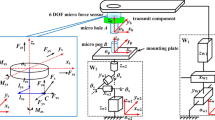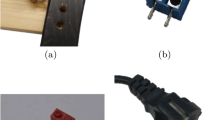Abstract
The peg-in-hole insertion and adjustment operation is one of the most common tasks in the robotic and automatic assembly processes. Fine motion strategies associated with adjustment operations on a peg-in-hole are fundamental manipulations that can be utilised in dynamic assembly and reconfigurable workholding or fixturing systems. This paper presents a comprehensive study of robotic-based height adjustment of a cylindrical pair based on maintaining minimum contact forces between the links. The outer link is held by the end-effector of a six-DOF (Degrees of freedom) serial articulated robot manipulator. The environment represented by the inner link can be either static or dynamic. A force-based approach and a d value approach are established to determine the type of contact that exists between the links of a cylindrical pair, and to extract control parameters. Based on the comparison and analysis of these two approaches, a hybrid methodology is established by combining a d value approach with a force-based approach for contact state determination. Formulations capable of extracting necessary control parameters, which ensure minimum contact forces between the links, are established from both planar and spatial viewpoints under both static and dynamic environmental conditions. Experimental results demonstrate the effectiveness of the proposed methodology.
Similar content being viewed by others
References
De Waas Tilakaratna P, Shirinzadeh B, Alici G (2003) Contact type determination for cylindrical pair adjustment. Proceeding of the IEEE/ASME International Conference on Advance Intelligent Mechatronics, Kobe, Japan, pp 326–331
Klingajay M, Seneviratne LD, Althoefer K (2003) Identification of threaded fastening parameters using the Newton Raphson Method. Proceedings of the IEEE/RSJ International Conference on Intelligent Robots and Systems, Las Vegas, USA, pp 2055–2060
Mason MT (1986) Mechanics and planning of manipulator pushing operations. Int J Rob Res 5(3):53–71
Nicolson EJ, Fearing RS (1993) Compliant control of threaded fastener insertion. Proceedings of the IEEE International Conference on Robotics and Automation, Atlanta, pp 484–490
Peshkin MA, Sanderson AC (1986) Manipulation of a sliding object. Proceedings of the IEEE International Conference on Robotics and Automation, San Francisco, pp 233–239
Shen YL, Shirinzadeh B (2001) Dynamic analysis of reconfigurable fixture construction by a manipulator. Robot Comput-Integr Manuf 17(5):367–377
Brokowski M, Peshkin M, Goldberg K (1995) Optimal curved fences for part alignment on a belt. Transactions of the ASME Journal of Mechanical Design 117(1):27–35
Peshkin MA, Sanderson AC (1988) The motion of a push sliding workpiece. IEEE J Robot Autom 4(6):569–598
Peshkin MA, Sanderson AC (1988) Planning robotic manipulations strategies for workpieces. IEEE J Robot Autom 4(5):524–531
Rusaw S, Gupta K, Payandeh S (2001) Flexible part orienting using rotation direction and force measurements. Int J Rob Res 20(6):484–505
Rusaw S, Gupta K, Payandeh S (1998) Orienting polygons with fences over a conveyor belt: empirical observations. Proceedings of the IEEE/RSJ International Conference on Intelligent Robots and Systems, Victoria, Canada, pp 831–836
Rusaw S, Gupta K, Payandeh S (1999) Part orienting with a force/torque sensor. Proceedings of the IEEE International Conference on Robotics and Automation, Detroit, pp 2545–2550
Lefebvre T, Bruyninckx H, De Schutter J (2003) Polyhedral contact formation modeling and identification for autonomous compliant motion. IEEE Trans Robot Autom 19(3):26–41
Lefebvre T, Bruyninckx H, De Schutter J (2005) Polyhedral contact formation identification for autonomous compliant motion: exact nonlinear Bayesian filtering. IEEE Trans Robot Autom 21(1):124–129
Gadeyne K, Lefebvre T, Bruyninck H (2005) Bayesian hybrid model-state estimation applied to simultaneous contact formation recognition and geometrical parameter estimation. Int J Rob Res 24(8):615–630
Klingajay M, Seneviratne LD, Althoefer K (2002) Parameter estimation during automated screw insertions. Proceedings of the IEEE International Conference on Industrial Technology, Bangkok, pp 1019–1024
Seneviratne LD, Visuwan P, Althoefer K (1999) Weightless neural network based monitoring of screw fastenings. Proceedings of the IEEE/RSJ International Conference on Intelligent Robots and Systems, Kyongju, pp 561–566
Shirinzadeh B (1995) Flexible and automated workholding systems. Ind Rob 22(2):29–34
Brost RC, Goldberg KY (1996) A complete algorithm for designing planar fixtures using modular components. IEEE Trans Robot Autom 12(1):31–46
Wallack AS, Canny JF (1997) Planning for modular and hybrid fixtures. Algorithmica 19(1–2):40–60
Shirinzadeh B, Tie Y (1995) Experimental investigation of the performance of a reconfigurable fixturing system. Int J Adv Manuf Technol 10(5):330–341
Asada HH, By AH (1985) Kinematic analysis and design for automatic workpart fixturing assembly. Proceedings of the 2nd International Symposium of Robotics Research, Kyoto, pp 237–244
Shirinzadeh B (2002) Flexible fixturing for workpiece positioning and constraining. Assem Autom 22(2):112–120
Qian WH, Qiao H (2002) An efficient algorithm for computing object poses in a modular fixture or gripper. J Robot Syst 19(3):99–114
Shirinzadeh B (1994) CAD-based design and analysis system for reconfigurable fixtures in robotic assembly. Comput Control Eng J 5(1):41–46
Wardak KR, Tasch U, Charalambides R (2001) Optimal fixture design for drilling through deformable plate workpieces—Part I: model formulation. J Manuf Syst 20(1):23–32
Shirinzadeh B (1996) A CAD-based hierarchical approach to interference detection among fixture modules in a reconfigurable fixturing system. Journal of Robotics & Computer-Integrated Manufacturing 12(1):41–53
Sudsang A, Ponce J, Srinivasa N (2000) Grasping and in-hand manipulation: geometry and algorithm. Algorithmica 26(3–4):466–493
Shirinzadeh B (1993) Issues in the design of the reconfigurable fixture modules for robotic assembly. J Manuf Syst 12(1):1–14
Zohoor H, Shahinpoor M (1991) Dynamic analysis of peg-in-hole insertion for manufacturing automation. J Manuf Syst 10(2):99–108
De Waas Tilakaratna P, Shirinzadeh B, Alici G (2004) Experimental investigation of 2D cylindrical pair height adjustment in a static environment. Proceedings of the 3rd IFAC Symposium on Mechatronic Systems, Sydney, pp 663–668
Shirinzadeh B (1998) Laser-interferometry-based tracking for dynamic measurements. Industrial Robot: An International Journal 25(1):35–41
Teoh PL, Shirinzadeh B, Foong CW, Alici G (2002) The measurement uncertainties in laser interferometry-based sensing and tracking technique. International Journal of Measurement 32(2):135–150
Alici G, Shirinzadeh B (2005) Enhanced stiffness modelling, identification and characterisation for robot manipulators. IEEE Trans Robot 21(4):554–564
Shirinzadeh B, Teoh PL, Tian Y, Dalvand MM, Zhong Y, Liaw HC (2010) Laser interferometry-based guidance methodology for high precision positioning of mechanisms and robots. Robot Comput-Integr Manuf 26(1):74–82
Author information
Authors and Affiliations
Corresponding author
Rights and permissions
About this article
Cite this article
Shirinzadeh, B., Zhong, Y., Tilakaratna, P.D.W. et al. A hybrid contact state analysis methodology for robotic-based adjustment of cylindrical pair. Int J Adv Manuf Technol 52, 329–342 (2011). https://doi.org/10.1007/s00170-010-2705-4
Received:
Accepted:
Published:
Issue Date:
DOI: https://doi.org/10.1007/s00170-010-2705-4




